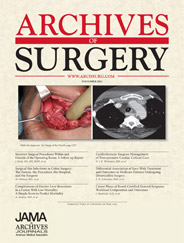据11月21日在线发表于《外科学文献》(Archives of Surgery)的一项研究表明,患者体重指数(BMI)是术后30 d死亡率的有效预测指标。通常,可以根据BMI看一个人是肥胖还是瘦弱。

研究者采用美国国家外科手术质量改进计划(NSQIP)数据库进行了一项大规模统计分析,共纳入189,533例接受过大型普通手术或血管手术的受试者,手术时间在2005和2006年,涉及183家医学中心。所有患者均接受了术前检查,研究者还对患者术后30 d的潜在死亡风险进行了评分,该评分综合考虑了患者的多项人口学特征(≥30项)、共病状况和实验室检测值。研究者根据患者BMI值的高低将其分入5组,还根据患者所接受的手术种类及预测后续死亡风险的相关需要,对数据进行了校正。
总计3,245例(1.7%)患者在术后30 d内死亡。BMI最低组(2.8%)也就是瘦弱患者术后死亡率是BMI最高组(1.0%)的2倍以上。与BMI处于居中范围的3组患者(1.8%,1.5%和1.4%)相比,BMI最低组患者的30 d死亡率显著升高。BMI值较高的2组患者30 d死亡率低于BMI正常组患者,但上述差异并无统计学意义。
研究者还按照患者的手术类型(45种不同手术)对数据做了进一步分析。接受腹腔镜手术(推荐术式)患者的总死亡率为2%,与之相比,接受开腹手术者的30 d死亡率则高达13.9%。BMI对患者30 d死亡率的影响在不同手术之间差异较大。高BMI增大了患者接受结肠造口术、伤口清创术、结直肠切除术、疝修补术和乳腺切除术等手术的术后30 d死亡率。
主要研究者、美国弗吉尼亚大学夏洛茨维尔分校外科学系的Florence E. Turrentine博士表示,即便医生已在术前根据患者个人情况评估过手术预期风险,并同意进行手术,低BMI(瘦弱)仍会使患者的术后风险提高。与体重正常的患者相比,肥胖患者的术后死亡风险反而更低(无统计学意义)。而BMI值最低的瘦弱患者(占总患者数的1/5,BMI<23.1 kg/m2)术后死亡风险显著增高,与BMI值处于中等范围的患者相比,其死亡风险比值比提高了40%。
既往研究表明,患者术后死亡率并不随着BMI增加而升高,但这些研究样本量较小且随访时间也较短。得益于该数据库庞大的样本基数,研究者首次得以对一些手术进行特异性评估。
研究者未披露任何经济利益冲突。

 The Relationship Between Body Mass Index and 30-Day Mortality Risk, by Principal Surgical Procedure
The Relationship Between Body Mass Index and 30-Day Mortality Risk, by Principal Surgical Procedure
Florence E. Turrentine, PhD, RN; John B. Hanks, MD; Bruce D. Schirmer, MD; George J. Stukenborg, PhD, MA
Objective To examine the relationship between body mass index (BMI; calculated as weight in kilograms divided by height in meters squared) and 30-day mortality risk among patients in the participant use data file database of the American College of Surgeons National Surgical Quality Improvement Program. Obesity is a prevalent chronic disease in the United States, and general and vascular surgeons are caring for an increasing population of obese patients.
Design Multivariable logistic regression analysis was used to assess the statistical significance of the relationship between BMI and mortality, with adjustments for patient-level differences in overall mortality risk and principal operating procedures. Odds ratios with 95% CIs were calculated to measure the relative difference in mortality by BMI quintile, with reference to the middle quintile of the BMI. The overall significance of the BMI and of the other covariates was measured using the Wald 2 test statistic. A separate multivariable logistic regression model was developed to assess the significance of the interaction between BMI and primary procedure.
Setting A total of 183 sites.
Patients Patients with major surgical procedures reported in the participant use data file database of the American College of Surgeons National Surgical Quality Improvement Program.
Results The data included 189 533 cases of general and vascular surgical procedures reported in 2005 and 2006 for patients with known overall probabilities of death. Among these, 3245 patients died within 30 days of their surgery (1.7%). Patients with a BMI of less than 23.1 demonstrated a significant increased risk of death, with 40% higher odds compared with patients in the middle range for BMI (26.3 to <29.7). Important differences in the association between BMI and mortality risk occur by type of primary procedure.
Conclusions Body mass index is a significant predictor of mortality within 30 days of surgery, even after adjusting for the contribution to mortality risk made by type of surgery and for a specific patient's overall expected risk of death.
文献链接:https://archsurg.ama-assn.org/cgi/reprint/archsurg.2011.310







